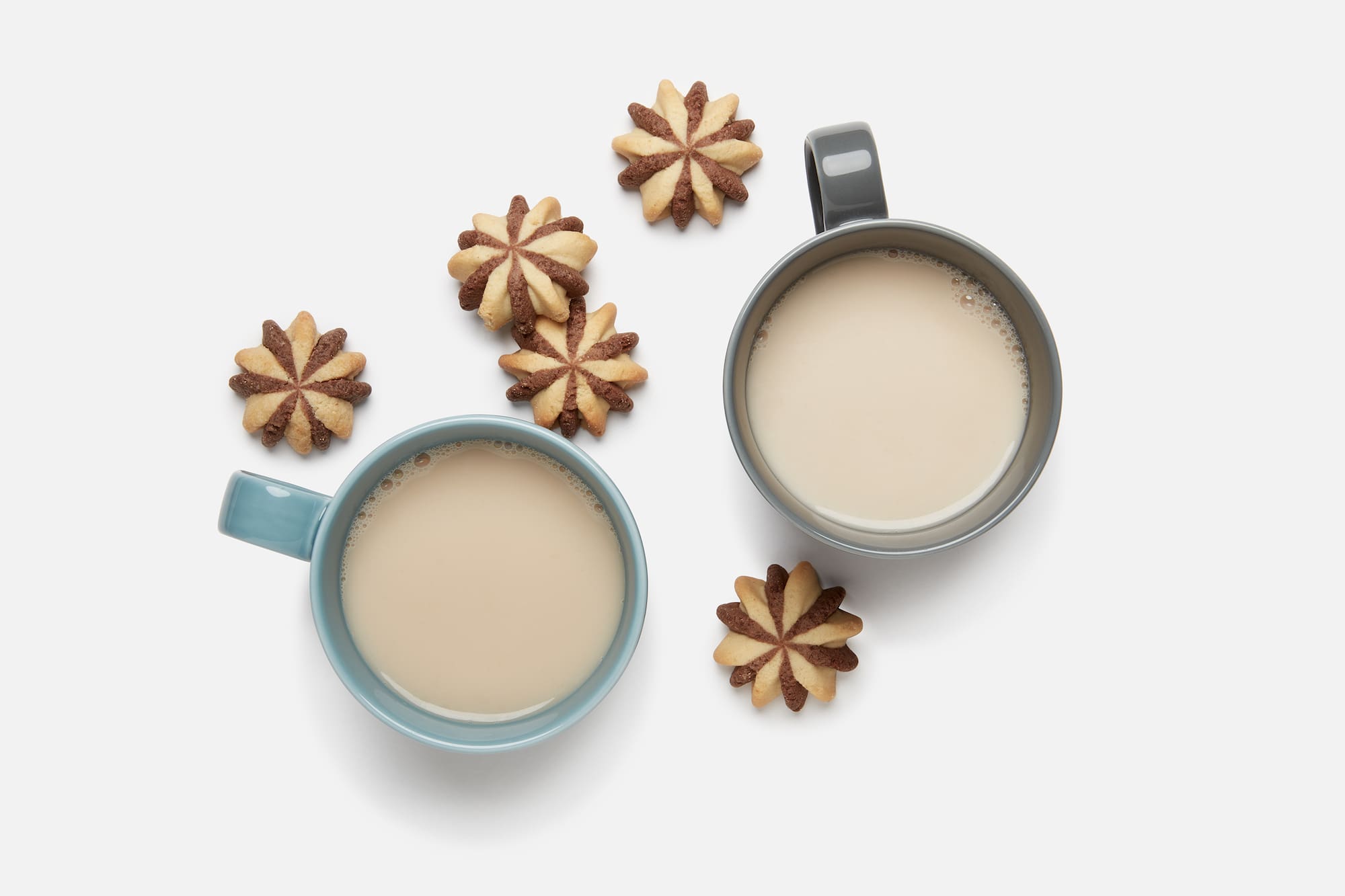We chatted over a cup with Michael Prini, tea sommelier and owner of the Canadian tea brand everyone’s talking about. —Catherine Dunwoody

Michael, thanks for chatting all things Blink Tea with us today! Tell us about being a tea sommelier.
Thanks for having me here! I received my Tea Sommelier designation in 2019. I took my course through the Tea and Herbal Association of Canada, which has a robust program they offer worldwide, and in a few different languages. The program I took is broken down into bite-sized modules and spans the history of tea-to-tea types, geography, cultivating, processing, tasting and health benefits, and even tea pairing with food and the business of tea. The course sets a very broad and comprehensive foundation, from which anyone with an interest in tea can explore and develop more.
What part of the course did you enjoy most?
The sommelier course involves a ton of tasting, which was my favourite part. The tastings, like you find in a wine sommelier course, are meant to educate your senses to the subtleties of taste and aroma. There’s also the visual element, what the tea leaves look like and why, and the liquor of the steeped teas. You take notes, you do comparisons between teas and really try to zero in on the uniqueness of each different tea type. There are only two different sub-species of tea leaves from which the majority of teas are created. And it is fascinating that weather, altitude, the millenniums-old skill set of the growers and processors can manipulate these leaves into teas, each of which that offer an entirely different sensory experience. At the end of each module, you give the instructor a short oral dissertation on an aspect of that module of your choosing. But to get your final designation requires passing a comprehensive blind taste test that encompasses the hundred or so teas you tasted throughout the entire eight module program. That, I have to say, is a nerve-wracking test to pass. All of the teas are blind-packaged, very hush hush. Someone has to prepare the teas for you, on camera, and you have to taste and identify each tea, on camera. A year and a half’s worth of work boils down to (pardon the pun) how you do on the blind taste test. It’s the final hill you climb to gain the designation. The sense of relief when you pass is kind of like winning a car.
Did you take the course before you opened Blink, or after?
I pursued my tea sommelier designation at the same time as I researched and built a business plan for Blink Tea. The sommelier program is offered online, comprising a series of eight modules. Prior to taking the course and setting up Blink Tea, I was a television producer. I produced a ton of HGTV shows, from Savoir Faire way back when HGTV launched in the late 1990’s, through to Sarah Richardson series like Room Service, Sarah’s House/ Cottage and Rental Cottage and more, landscape design series Dirty Business and real estate realty check series Critical Listing. While I produced television, I was pretty much addicted to espresso, with the occasional derivation to tea. But to credibly launch a business and because I’m obsessively detail oriented, I had to do a deeper dive into tea. Being a Gemini I love to do a number of things at the same time, so becoming a tea sommelier and learning the ins and outs of the tea business seemed to create a happy coupling,
When did you open Blink?
Blink Tea was launched at the very end of 2018. We first launched the online shop and soon followed with wholesale to restaurants, cafes and shops.
Tell us how one determines which tea to choose?
One of the glories of tea is that it dovetails more into the experience you’re seeking, and that’s what drove me to categorize teas by Bold, Medium and Mild. Our goal has always been to connect the dots between you and a great cup of tea that nails your need or mood. No one else was doing that. We’ve selected a variety of teas that will give you a morning boost, offer an exotic flavour break in the afternoon or caffeine free tastes to button up a busy day. You can still drink whatever you want whenever you want it, but we wanted to provide a bit of simple guidance, to be a bit more pro-active. We’re leveraging our knowledge to make your tea experience pretty fabulous no matter what or when or how you wish to enjoy.
Let’s talk water temperature for various teas. Since most of us do not know the temperature water is at after boiling, what is a good rule of thumb?
If you’re a tea lover, there’s a good chance you have a variable temperature kettle, and it’s as simple as following the steeping instructions on any tea package. For those who have a kettle that only boils water, there’s a pretty simple, yet extremely important formula. Boiling water is 100 degrees Celsius or 212 degrees Fahrenheit. For black teas, I would allow the boiled water to cool for a minute or so before pouring over your tea. For oolongs and green teas, it’s best to let boiling water cool for a good 5 minutes. And for white teas, the most delicate of leaves, I’d honestly give boiling water a good 5 – 7 minutes to cool down before making a cup. Boiling hot water will scald tea leaves, giving you a bitter taste. I know that many of us, myself included, can be impatient, but you’ll be rewarded by a cup of tea that tastes the way it authentically should. Just add the time for allowing boiled water to cool to your mindful, me moment. Goodness knows, we could all use more of those! A rough tea water temps guide:
- Black teas – 95 – 100 degrees Celsius
- Oolongs – 80 – 85 degrees Celsius
- Green teas – 70 – 80 degrees Celsius
- White teas – 70 degrees Celsius
Any trends in teas? Any unsung heroes we should try?
Flavour continues to be a driver of interest in tea. People are looking for uniquely scented teas. While Cream of Earl Grey continues to be a top seller across the board, blends using other unique florals, fruits and herbs are giving it a run for the money. The true test of a good blend is balance of flavour. You should be able to taste the tea and the other elements of the blend in unison. One flavour shouldn’t overtake the other, the tastes should complement rather than fight for attention. Herbals are another big trend in teas. They have no actual tea in them at all, rather herbals are blends of botanicals. Again, the choice for herbal teas is endless, with new blends being introduced almost daily. The benefit of herbal teas is that they are generally caffeine-free, which is becoming more important for many people. Pu’erh teas are an unsung hero tea type. The rarest and most expensive pu’erh teas are fermented in deep dark caves, often for many years. They are the stuff of legend. Less costly pu’erh teas are non-fermented, but also share an earthy, mushroomy satisfaction of the fermented variety. They are definitely worth a try.
Any other info, tips you want to share? We love what we’re learning from you.
- When making a cup of tea, always add water to tea and not tea to water. Your tea will never steep properly.
- Follow the package directions when making tea—they exist to maximize your enjoyment
- Never, ever squeeze a tea bag when removing it from a cup or a teapot. It releases bitter tannins back into your tea.
- Cold tea in a smoothie instead of milk can add taste and cut calories.
- Teas, matcha and tea latte blends are supreme in baked goods. Some teas like a masala chai will get more flavourful day after day.
- Teas make amazing simple syrups for cocktails and mocktails and they’re so easy to whip up.
- Green teas can be used to create or add to soup stock, again adding a flavour twist while cutting calories.
- Teas can be used to create dips and spreads. A smoky lapsang souchong tea works wonders in a spice rub.

Be the first to comment